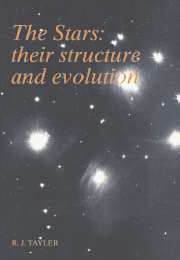Book contents
- Frontmatter
- Contents
- Preface
- Symbols
- Numerical values
- 1 Introduction
- 2 Observational properties of stars
- 3 The equations of stellar structure
- 4 The physics of stellar interiors
- 5 The structure of main sequence stars and pre-main-sequence evolution
- 6 Early post-main-sequence evolution and the ages of star clusters
- 7 Mass loss from stars
- 8 Close binary stars
- 9 Advanced evolutionary phases
- 10 The final stages of stellar evolution: white dwarfs, brown dwarfs, neutron stars and black holes
- 11 Concluding remarks
- Appendix 1 Thermodynamic equilibrium
- Appendix 2 The equation of radiative transfer
- Appendix 3 The pressure of a degenerate gas
- Suggestions for further reading
- Index
7 - Mass loss from stars
Published online by Cambridge University Press: 05 June 2012
- Frontmatter
- Contents
- Preface
- Symbols
- Numerical values
- 1 Introduction
- 2 Observational properties of stars
- 3 The equations of stellar structure
- 4 The physics of stellar interiors
- 5 The structure of main sequence stars and pre-main-sequence evolution
- 6 Early post-main-sequence evolution and the ages of star clusters
- 7 Mass loss from stars
- 8 Close binary stars
- 9 Advanced evolutionary phases
- 10 The final stages of stellar evolution: white dwarfs, brown dwarfs, neutron stars and black holes
- 11 Concluding remarks
- Appendix 1 Thermodynamic equilibrium
- Appendix 2 The equation of radiative transfer
- Appendix 3 The pressure of a degenerate gas
- Suggestions for further reading
- Index
Summary
Introduction
In most of my previous discussion I have assumed that stars spend their entire life with a constant mass, whose chemical composition changes as a result of nuclear reactions. I have also mentioned that, in fact, mass loss from stars is important and I shall now say more about this subject. Observationally mass loss is apparent in the explosions of supernovae and, to a lesser extent, novae and it is also clear that planetary nebulae are formed of mass ejected by stars. Evidence of mass loss from ordinary stars has only been well-established since the development of space astronomy as will become clear in what follows. In this chapter I shall restrict myself to a discussion of mass loss from single stars or from binary stars whose separation is so great that the two components evolve independently. In the next chapter I shall discuss mass exchange between components in close binary systems, which may also involve mass loss from the entire system.
The solar wind
It has been known since about 1960 that the Sun is losing mass at a rate of between one part in 1014 and one part in 1013 a year. This loss is known as the solar wind because it flows through interplanetary space and past the Earth with a velocity of several hundred kilometres a second.
- Type
- Chapter
- Information
- The StarsTheir Structure and Evolution, pp. 168 - 176Publisher: Cambridge University PressPrint publication year: 1994



